Free Courses Sale ends Soon, Get It Now


Free Courses Sale ends Soon, Get It Now


DISEASES AND ITS TYPES
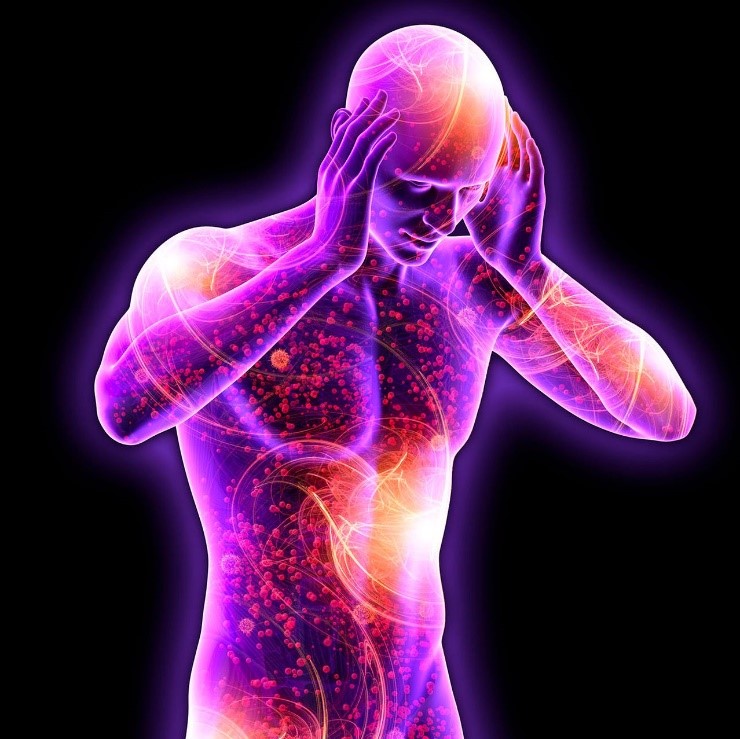
Disclaimer: Copyright infringement not intended.
Diseases are abnormal conditions that affect the body's normal functioning. They can be caused by pathogens such as bacteria, viruses, fungi, or parasites, as well as by non-infectious factors such as genetic mutations, lifestyle choices, and environmental factors.
Types of Diseases
Each of these types of diseases has its own characteristics, modes of transmission, and treatment options. Understanding these differences is important for effective prevention and management.
ZOONOTIC DISEASES
Zoonotic diseases are infectious diseases that can be transmitted between animals and humans. These diseases can be caused by bacteria, viruses, parasites, and fungi. Here are some key points about zoonotic diseases:
Transmission: Zoonotic diseases can be transmitted to humans through direct contact with infected animals or their secretions, bites from infected animals, consumption of contaminated food or water, and exposure to environments contaminated with animal waste.
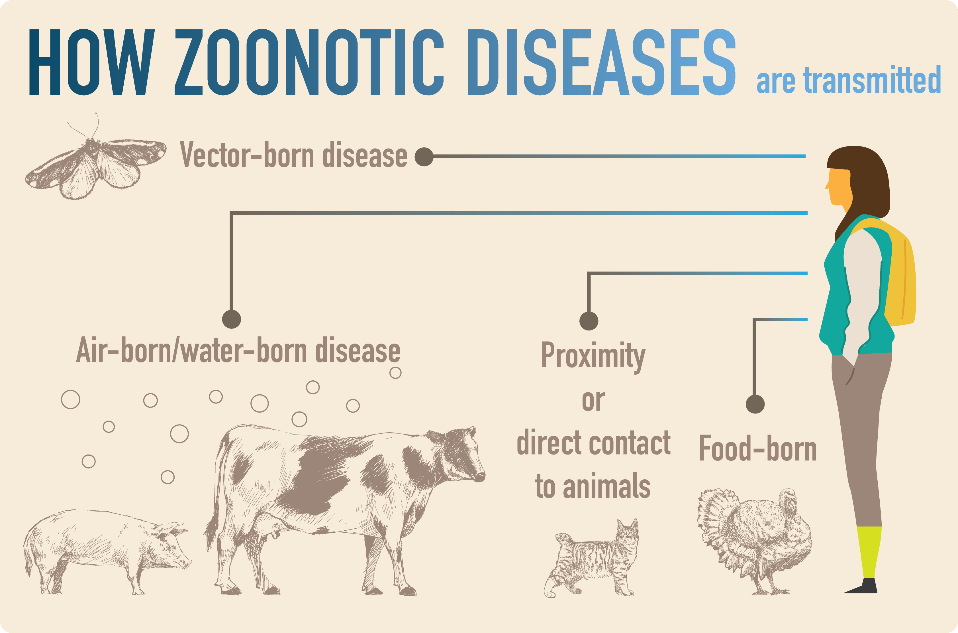
Here is a list of some common zoonotic diseases:
Rabies: A viral disease that affects the central nervous system. It is usually transmitted through the bite of an infected animal, such as a dog or bat.
Brucellosis: Caused by bacteria of the genus Brucella, this disease can be transmitted to humans through contact with infected animals or consumption of contaminated dairy products.
Leptospirosis: A bacterial disease that can be transmitted to humans through contact with water or soil contaminated with the urine of infected animals, such as rodents and livestock.
Q Fever: Caused by the bacterium Coxiella burnetii, this disease is usually transmitted to humans through inhalation of contaminated dust particles or contact with infected animals, particularly livestock.
Anthrax: Caused by the bacterium Bacillus anthracis, anthrax can affect both animals and humans. It is usually transmitted through contact with infected animals or their products.
Avian Influenza (Bird Flu): A viral disease that primarily affects birds but can also infect humans who come into close contact with infected birds or contaminated environments.
West Nile Virus: Transmitted to humans through the bite of infected mosquitoes, this virus can also affect birds and other animals.
Lyme Disease: Caused by the bacterium Borrelia burgdorferi, Lyme disease is transmitted to humans through the bite of infected black-legged ticks.
Toxoplasmosis: A parasitic disease caused by the protozoan Toxoplasma gondii, which can be transmitted to humans through contact with infected cats or consumption of contaminated food or water.
Ebola Virus Disease: A severe, often fatal illness in humans caused by the Ebola virus. It is transmitted to people from wild animals and spreads through human-to-human transmission.
Salmonellosis: Caused by the bacterium Salmonella, this disease is often associated with food poisoning but can also be transmitted through contact with infected animals, especially reptiles and birds.
Campylobacteriosis: Caused by the bacterium Campylobacter, this disease is commonly transmitted to humans through consumption of contaminated food, particularly poultry.
Cryptosporidiosis: A parasitic disease caused by the protozoan Cryptosporidium, which can be transmitted to humans through contaminated water, food, or contact with infected animals.
Echinococcosis: Also known as hydatid disease, this is a parasitic disease caused by tapeworms of the genus Echinococcus. It is transmitted to humans through contact with infected animals, particularly dogs.
Hantavirus Pulmonary Syndrome: A serious respiratory disease caused by exposure to the droppings, urine, or saliva of infected rodents.
Lassa Fever: A viral hemorrhagic fever transmitted to humans through contact with food or household items contaminated with the urine or feces of infected rodents.
Tuberculosis (TB): Although primarily a disease of the lungs in humans, TB can also affect animals. The bovine form of TB can be transmitted to humans through consumption of contaminated dairy products.
Monkeypox: A viral disease similar to smallpox, transmitted to humans from animals such as rodents and primates.
Scabies: While primarily a skin infestation caused by mites, some species of Sarcoptes mites can be transmitted between humans and animals.
Ringworm: A fungal infection that can affect the skin, scalp, or nails of humans and animals, transmitted through direct contact with infected animals or their environment.
Prevention:
HEREDITARY DISEASES
Hereditary diseases, also known as genetic disorders, are conditions caused by abnormalities in an individual's genetic material (DNA). These disorders can be inherited from one or both parents and can be present from birth or develop later in life. Here are some key points about hereditary diseases:
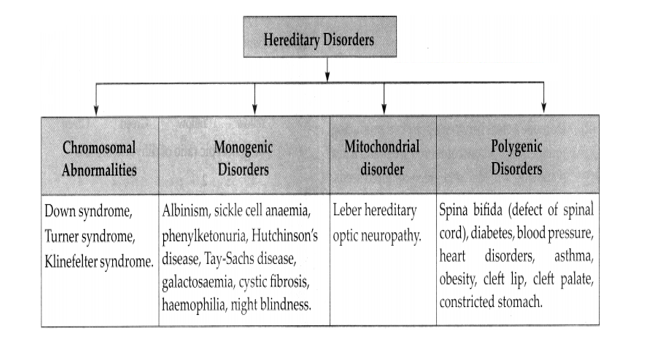
Here are some examples of hereditary diseases:
Cystic Fibrosis: A genetic disorder that affects the lungs and digestive system, causing severe respiratory and digestive problems.
Sickle Cell Anemia: A genetic disorder that affects the red blood cells, causing them to be abnormally shaped and leading to various complications such as pain, anemia, and organ damage.
Hemophilia: A genetic disorder that impairs the body's ability to control blood clotting, leading to excessive bleeding and bruising.
Muscular Dystrophy: A group of genetic disorders characterized by progressive muscle weakness and degeneration.
Huntington's Disease: A genetic disorder that causes progressive degeneration of nerve cells in the brain, leading to movement, cognitive, and psychiatric symptoms.
Down Syndrome: A genetic disorder caused by the presence of an extra chromosome 21, resulting in developmental delays and intellectual disabilities.
Thalassemia: A genetic disorder that affects the production of hemoglobin, leading to anemia and other complications.
Tay-Sachs Disease: A genetic disorder that causes progressive destruction of nerve cells in the brain and spinal cord.
Familial Hypercholesterolemia: A genetic disorder characterized by high levels of cholesterol in the blood, leading to an increased risk of heart disease.
Polycystic Kidney Disease: A genetic disorder characterized by the growth of cysts in the kidneys, leading to kidney damage and failure.
Fragile X Syndrome: A genetic disorder that causes intellectual disability, behavioral and learning challenges, and various physical characteristics.
Marfan Syndrome: A genetic disorder that affects the body's connective tissue, leading to skeletal, cardiovascular, and ocular abnormalities.
Phenylketonuria (PKU): A genetic disorder that affects the body's ability to break down the amino acid phenylalanine, leading to intellectual disability and other symptoms if left untreated.
Duchenne Muscular Dystrophy: A genetic disorder characterized by progressive muscle degeneration and weakness.
Spinal Muscular Atrophy (SMA): A genetic disorder that affects the motor neurons in the spinal cord, leading to muscle weakness and atrophy.
Hemochromatosis: A genetic disorder that causes the body to absorb and store too much iron, leading to organ damage.
Albinism: A genetic disorder characterized by a lack of melanin pigment in the skin, hair, and eyes, leading to vision problems and increased susceptibility to sun damage.
Sickle Cell Disease: A group of genetic disorders that affect hemoglobin, leading to the production of abnormal hemoglobin molecules and the characteristic sickle-shaped red blood cells.
Polycystic Ovary Syndrome (PCOS): While not exclusively hereditary, PCOS has a genetic component and is characterized by hormonal imbalances that can lead to irregular periods, ovarian cysts, and infertility.
Gaucher Disease: A genetic disorder that results in the buildup of fatty substances in certain organs, particularly the spleen and liver.
Fabry Disease: A genetic disorder that results in the buildup of a type of fat called globotriaosylceramide in the body's cells, leading to various symptoms such as pain, kidney problems, and skin abnormalities.
Wilson Disease: A genetic disorder that causes copper to accumulate in the liver, brain, and other organs, leading to liver disease, neurological problems, and other complications.
Hemochromatosis: A genetic disorder that causes the body to absorb and store too much iron, leading to organ damage.
Alpha-1 Antitrypsin Deficiency: A genetic disorder that can cause lung and liver disease.
Hereditary Hemorrhagic Telangiectasia (HHT): A genetic disorder that leads to abnormal blood vessel formation in the skin, mucous membranes, and often in organs such as the lungs, liver, and brain.
Familial Mediterranean Fever: A genetic autoinflammatory disorder characterized by recurrent episodes of fever and inflammation in the abdomen, chest, or joints.
Neurofibromatosis: A genetic disorder that causes tumors to form on nerve tissue, leading to various complications depending on the type.
Familial Adenomatous Polyposis (FAP): A genetic disorder that causes numerous polyps to form in the colon and rectum, increasing the risk of colorectal cancer.
Treatment:
Treatment for hereditary diseases varies depending on the specific disorder. It may include medications, dietary changes, physical therapy, and surgery.
Gene therapy, which involves replacing or repairing faulty genes, is an emerging treatment option for some hereditary diseases.
Prevention:
Genetic counseling can help individuals understand their risk of passing on hereditary diseases and make informed decisions about family planning.
Prenatal testing can detect certain hereditary diseases in the fetus, allowing parents to make decisions about the pregnancy.
PROTOZOAN DISEASES
Protozoan diseases are illnesses caused by single-celled eukaryotic organisms called protozoa. These organisms can be parasitic and are commonly found in soil, water, and animals.
Transmission: Protozoa can be transmitted to humans through contaminated water or food, insect vectors (such as mosquitoes), or contact with infected animals.
Here are some examples of protozoan diseases:
Malaria: A mosquito-borne disease caused by the Plasmodium parasite. It is characterized by symptoms such as fever, chills, and flu-like illness and can be life-threatening if not treated promptly.
Amoebiasis: Caused by the protozoan parasite Entamoeba histolytica, this disease can cause dysentery (bloody diarrhea) and liver abscesses.
Giardiasis: Caused by the protozoan parasite Giardia lamblia, this disease can cause diarrhea, abdominal cramps, and bloating.
Toxoplasmosis: Caused by the protozoan parasite Toxoplasma gondii, this disease can be contracted by ingesting contaminated food or water or through contact with infected cat feces. It can cause flu-like symptoms in healthy individuals but can be serious in pregnant women and people with weakened immune systems.
Cryptosporidiosis: Caused by the protozoan parasite Cryptosporidium, this disease can cause diarrhea, stomach cramps, and vomiting. It is often spread through contaminated water.
African Trypanosomiasis (Sleeping Sickness): Caused by the protozoan parasites Trypanosoma brucei gambiense and Trypanosoma brucei rhodesiense, this disease is transmitted by tsetse flies in sub-Saharan Africa and can cause fever, headaches, and neurological problems.
Chagas Disease: Caused by the protozoan parasite Trypanosoma cruzi, this disease is transmitted by triatomine bugs and can cause fever, swelling at the site of infection (chagoma), and in later stages, heart and digestive problems.
Leishmaniasis: Caused by various species of the Leishmania parasite, this disease is transmitted by sandflies and can cause skin sores (cutaneous leishmaniasis) or more severe systemic symptoms (visceral leishmaniasis).
Amebic Meningoencephalitis: Caused by the protozoan Naegleria fowleri, this rare but often fatal disease affects the brain and spinal cord. It is usually contracted by swimming in warm freshwater lakes or rivers.
Babesiosis: Caused by the protozoan parasites of the genus Babesia, this disease is transmitted by ticks and can cause flu-like symptoms, anemia, and other complications.
Balantidiasis: Caused by the protozoan parasite Balantidium coli, this disease can infect the intestines and cause diarrhea, abdominal pain, and other gastrointestinal symptoms.
Cyclosporiasis: Caused by the protozoan parasite Cyclospora cayetanensis, this disease is transmitted through contaminated food or water and can cause diarrhea, stomach cramps, and other gastrointestinal symptoms.
Isosporiasis: Caused by the protozoan parasite Cystoisospora belli, this disease can cause diarrhea, abdominal pain, and other gastrointestinal symptoms.
Microsporidiosis: Caused by various species of microsporidia, this disease can affect various organs and tissues, causing symptoms such as diarrhea, eye infections, and respiratory problems.
Pneumocystis pneumonia (PCP): Caused by the fungus-like protozoan Pneumocystis jirovecii, this disease primarily affects people with weakened immune systems, such as those with HIV/AIDS, and can cause pneumonia-like symptoms.
VIRAL DISEASES
Viral diseases are illnesses caused by viruses, which are microscopic infectious agents that replicate inside the cells of living hosts. Viruses can infect humans, animals, plants, and even bacteria. Here are some key points about viral diseases:
Transmission: Viruses can be transmitted through various means, including:
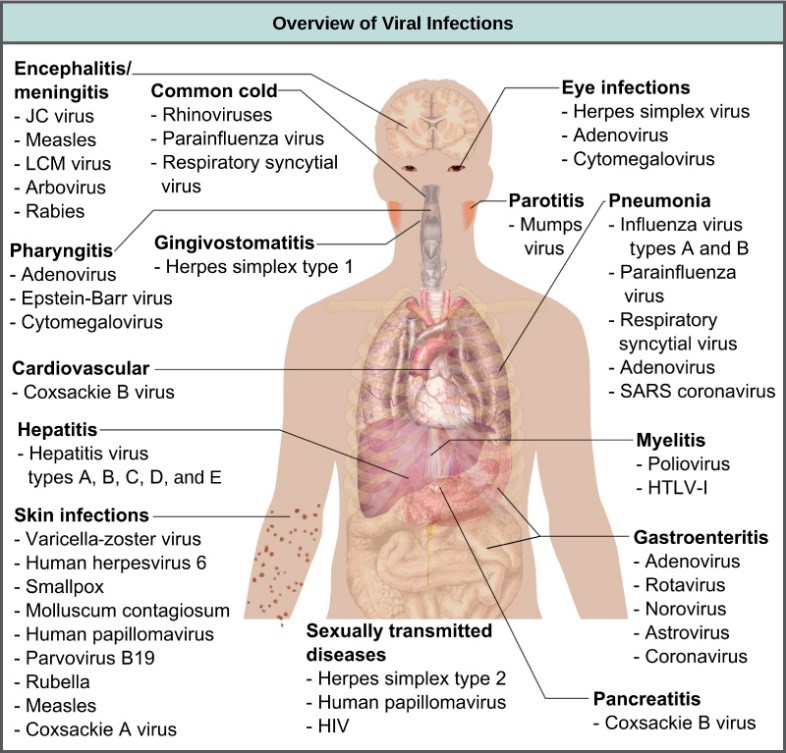
Here are some examples of viral diseases:
COVID-19: Caused by the novel coronavirus SARS-CoV-2, COVID-19 has led to a global pandemic since its emergence in late 2019. It primarily spreads through respiratory droplets and can cause a range of symptoms from mild to severe, including fever, cough, and difficulty breathing.
Influenza (Flu): Caused by influenza viruses, the flu is a contagious respiratory illness with symptoms such as fever, cough, sore throat, runny or stuffy nose, muscle or body aches, and fatigue.
HIV/AIDS: Human Immunodeficiency Virus (HIV) attacks the immune system, specifically the CD4 cells (T cells), and can lead to Acquired Immunodeficiency Syndrome (AIDS), a condition in which the immune system is severely compromised.
Hepatitis: Hepatitis viruses (A, B, C, D, and E) can cause inflammation of the liver, leading to symptoms such as jaundice, fatigue, abdominal pain, and in severe cases, liver failure.
Herpes Simplex Virus (HSV): HSV-1 and HSV-2 can cause oral and genital herpes, respectively, characterized by painful sores or blisters.
Varicella-Zoster Virus (VZV): Causes chickenpox (varicella) and shingles (herpes zoster), with chickenpox presenting as itchy blisters and shingles as a painful rash.
Measles: A highly contagious viral disease characterized by a rash, fever, cough, runny nose, and red, watery eyes.
Rubella (German Measles): A viral infection causing a mild fever and a rash, especially in children, but can have serious consequences if contracted by pregnant women, leading to birth defects.
Dengue Fever: Transmitted by mosquitoes, dengue fever causes high fever, severe headache, pain behind the eyes, joint and muscle pain, rash, and mild bleeding.
Ebola Disease: A severe, often fatal illness in humans caused by the Ebola virus. It is transmitted to people from wild animals and spreads through human-to-human transmission.
Zika Virus: Transmitted primarily through the bite of infected Aedes mosquitoes, Zika virus infection during pregnancy can cause severe birth defects, including microcephaly.
West Nile Virus: Transmitted to humans through the bite of infected mosquitoes, most people infected with West Nile virus do not develop any symptoms, but some may experience fever, headache, body aches, joint pains, vomiting, diarrhea, or rash.
Rabies: A viral disease that causes inflammation of the brain in humans and other mammals. It is transmitted through the saliva of an infected animal, usually through a bite.
Norovirus: A highly contagious virus that causes gastroenteritis, leading to symptoms such as diarrhea, vomiting, stomach cramps, and nausea.
Rotavirus: A common cause of diarrheal illness in infants and young children, which can lead to severe dehydration and even death in some cases.
Respiratory Syncytial Virus (RSV): A common respiratory virus that can cause mild, cold-like symptoms in adults and older children, but can lead to more serious respiratory infections in infants and young children.
Hantavirus Pulmonary Syndrome: A severe respiratory disease caused by exposure to the droppings, urine, or saliva of infected rodents.
Cytomegalovirus (CMV): A common virus that can infect people of all ages. Most people with CMV have no symptoms and may not even know that they have been infected, but it can cause serious health problems in people with weakened immune systems and in newborns infected with the virus before birth.
Human Papillomavirus (HPV): A group of viruses that can infect the skin and mucous membranes. Some types of HPV can cause warts, while others can lead to cancers of the cervix, vulva, vagina, penis, anus, and oropharynx.
Adenovirus Infection: Adenoviruses can cause a range of illnesses, including respiratory, gastrointestinal, and eye infections.
Yellow Fever: A viral disease transmitted by infected mosquitoes in tropical regions of Africa and South America. It can cause fever, jaundice, and in severe cases, organ failure.
Japanese Encephalitis: A viral infection transmitted by mosquitoes in parts of Asia and the western Pacific. It can cause inflammation of the brain (encephalitis) and severe complications.
Hand, Foot, and Mouth Disease (HFMD): A viral illness common in children, characterized by sores in the mouth and a rash on the hands and feet. It is usually caused by enteroviruses, particularly Coxsackievirus A16.
Chikungunya Fever: A viral disease transmitted by mosquitoes that causes fever and severe joint pain. It is common in Africa, Asia, and the Indian subcontinent.
Hantavirus: Besides causing hantavirus pulmonary syndrome (HPS), hantaviruses can also cause hemorrhagic fever with renal syndrome (HFRS), both of which are serious illnesses.
Mumps: A viral infection that primarily affects the salivary glands, causing swelling and pain. It can also lead to complications such as meningitis and deafness.
Rift Valley Fever: A viral disease that primarily affects animals but can also infect humans. It is transmitted by mosquitoes and can cause severe disease in both animals and humans.
Hand-Schuller-Christian Disease: A rare form of Langerhans cell histiocytosis, which is a group of disorders involving certain cells that normally have a protective function.
Progressive Multifocal Leukoencephalopathy (PML): A rare and often fatal viral disease characterized by progressive damage or inflammation of the white matter of the brain.
Viral Hemorrhagic Fevers (VHFs): A group of illnesses caused by several distinct families of viruses, including Ebola, Marburg, Lassa, and Crimean-Congo hemorrhagic fever viruses. These diseases are characterized by fever and bleeding disorders and can be severe or fatal.
Epstein-Barr Virus (EBV) Infection: Also known as mononucleosis or "mono," this viral infection can cause fever, sore throat, swollen lymph nodes, and fatigue.
Cytomegalovirus (CMV) Infection: While often asymptomatic in healthy individuals, CMV infection can cause severe illness in people with weakened immune systems or in newborns infected before birth.
Norovirus Infection: Noroviruses are a common cause of viral gastroenteritis, often leading to vomiting, diarrhea, and stomach cramps.
Human T-lymphotropic Virus (HTLV) Infection: HTLV can cause several diseases, including a rare type of leukemia, as well as inflammatory conditions such as HTLV-associated myelopathy/tropical spastic paraparesis (HAM/TSP).
Colorado Tick Fever: A viral infection transmitted by the bite of infected ticks, causing symptoms such as fever, chills, headache, and muscle aches.
BACTERIAL DISEASES
Bacterial diseases are illnesses caused by harmful bacteria that invade the body and multiply, leading to infection. Bacteria are single-celled microorganisms that can be found in various environments, including soil, water, and the human body. Here are some key points about bacterial diseases:
Transmission: Bacterial diseases can be transmitted through various means, including:
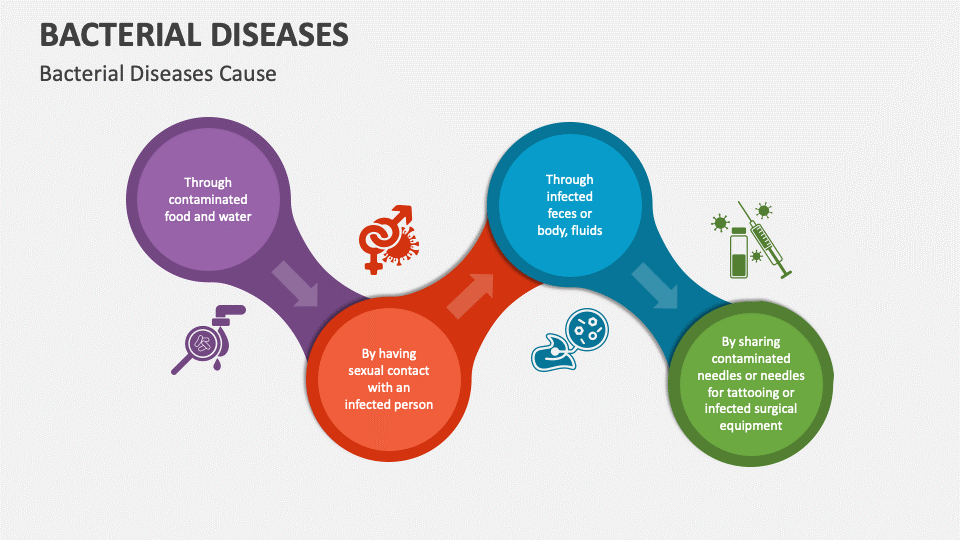
Here are some examples of bacterial diseases:
Tuberculosis (TB): A bacterial infection caused by Mycobacterium tuberculosis, typically affecting the lungs but can also affect other parts of the body. It is spread through the air when an infected person coughs or sneezes.
Pneumonia: An infection that inflames the air sacs in one or both lungs, which may fill with fluid or pus. Bacterial pneumonia is caused by various bacteria, including Streptococcus pneumoniae.
Staphylococcal Infections: Caused by Staphylococcus bacteria, these infections can range from minor skin infections to more serious conditions such as pneumonia, meningitis, and sepsis.
Streptococcal Infections: Caused by Streptococcus bacteria, these infections can cause a range of illnesses, including strep throat, scarlet fever, and invasive infections such as pneumonia and necrotizing fasciitis (flesh-eating disease).
Cholera: A bacterial infection caused by Vibrio cholerae, typically spread through contaminated water or food, leading to severe diarrhea and dehydration.
Leprosy: A chronic bacterial infection caused by Mycobacterium leprae, affecting the skin, nerves, and mucous membranes. It is transmitted through respiratory droplets.
Tetanus: A bacterial infection caused by Clostridium tetani bacteria, usually entering the body through a wound. It leads to muscle stiffness and can be life-threatening.
Diphtheria: A bacterial infection caused by Corynebacterium diphtheriae, usually affecting the throat and upper respiratory tract. It can lead to breathing difficulties and heart failure.
Gonorrhea: A sexually transmitted bacterial infection caused by Neisseria gonorrhoeae, affecting the genitals, rectum, and throat.
Lyme Disease: Caused by the bacterium Borrelia burgdorferi, transmitted to humans through the bite of infected ticks. It can lead to fever, headache, fatigue, and a characteristic skin rash.
Syphilis: A sexually transmitted infection caused by the bacterium Treponema pallidum, which can lead to long-term complications if not treated early.
Anthrax: A serious infectious disease caused by the bacterium Bacillus anthracis, which can affect the skin, lungs, and digestive system.
Tularemia: Also known as rabbit fever, tularemia is caused by the bacterium Francisella tularensis and can be transmitted to humans through contact with infected animals or bites from infected insects.
Legionnaires' Disease: A severe form of pneumonia caused by the bacterium Legionella pneumophila, typically contracted by inhaling the bacteria from contaminated water or soil.
Pertussis (Whooping Cough): A highly contagious respiratory disease caused by the bacterium Bordetella pertussis, characterized by severe coughing fits.
Gastroenteritis: While often caused by viruses, bacterial gastroenteritis can occur due to bacterial infections such as Salmonella, Escherichia coli (E. coli), and Campylobacter.
Meningococcal Disease: Caused by the bacterium Neisseria meningitidis, this disease can lead to meningitis (inflammation of the membranes surrounding the brain and spinal cord) and septicemia (blood poisoning).
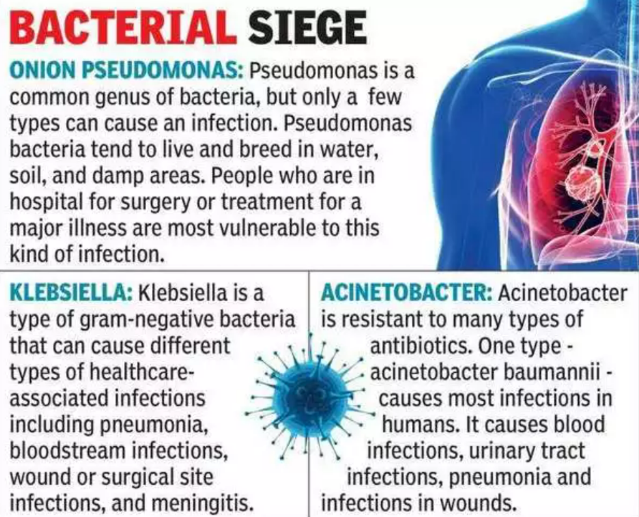
Leprosy: Also known as Hansen's disease, leprosy is caused by the bacterium Mycobacterium leprae and primarily affects the skin and nerves.
Pseudomonas Infections: Caused by the bacterium Pseudomonas aeruginosa, these infections can affect various parts of the body and are often associated with healthcare settings.
Yersinia pestis Infection (Plague): Caused by the bacterium Yersinia pestis, plague can manifest as bubonic, septicemic, or pneumonic forms, with symptoms ranging from fever and chills to respiratory failure.
Brucellosis: A bacterial infection transmitted to humans from animals, particularly livestock, and characterized by fever, joint pain, and fatigue.
Clostridium difficile Infection: Often referred to as C. diff, this infection can cause diarrhea and colitis (inflammation of the colon) and is commonly associated with antibiotic use.
Listeriosis: Caused by the bacterium Listeria monocytogenes, this infection is often contracted through contaminated food and can lead to severe illness, particularly in pregnant women, newborns, and individuals with weakened immune systems.
Whipple's Disease: A rare bacterial infection caused by Tropheryma whipplei, which can affect various parts of the body, including the gastrointestinal tract, joints, and central nervous system.
Anaplasmosis: A tick-borne disease caused by the bacterium Anaplasma phagocytophilum, leading to flu-like symptoms and, in severe cases, organ failure.
Bacterial Meningitis: Besides being mentioned earlier, bacterial meningitis can also be caused by other bacteria such as Haemophilus influenzae, Streptococcus pneumoniae, and Listeria monocytogenes.
Actinomycosis: A rare bacterial infection caused by Actinomyces species, typically affecting the face, neck, or lungs and forming abscesses or draining sinuses.
Chancroid: A sexually transmitted infection caused by the bacterium Haemophilus ducreyi, characterized by genital ulcers and swelling of the lymph nodes in the groin.
Lymphogranuloma Venereum (LGV): A sexually transmitted infection caused by certain serotypes of the bacterium Chlamydia trachomatis, leading to swelling and inflammation of the lymph nodes in the genital or anal area.
Melioidosis: A tropical infectious disease caused by the bacterium Burkholderia pseudomallei, primarily affecting people with underlying health conditions and those exposed to contaminated soil or water.
Necrotizing Fasciitis: Also known as flesh-eating bacteria, this severe bacterial infection affects the skin, subcutaneous tissues, and fascia, often leading to tissue death and systemic illness.
Q Fever: A bacterial infection caused by Coxiella burnetii, typically transmitted to humans from infected animals, leading to flu-like symptoms and, in some cases, chronic illness.
Rocky Mountain Spotted Fever: A bacterial infection transmitted by ticks, causing fever, headache, and a characteristic rash. It can be severe if not treated promptly.
Shigellosis: Caused by Shigella bacteria, this infection causes diarrhea (often bloody), fever, and stomach cramps, typically lasting 5 to 7 days.
Trench Fever: Caused by the bacterium Bartonella quintana, this infection is transmitted by body lice and can lead to fever, headache, and muscle aches.
Yersiniosis: Caused by the bacterium Yersinia enterocolitica, this infection is often associated with contaminated food or water and can lead to symptoms such as fever, abdominal pain, and diarrhea.
Symptoms:
Symptoms of bacterial diseases vary depending on the type of bacteria and the site of infection but may include fever, cough, diarrhea, vomiting, rash, and pain or swelling at the site of infection.
Diagnosis and Treatment:
Diagnosis of bacterial diseases often involves laboratory tests, including blood cultures, urine cultures, and imaging studies.
Treatment for bacterial diseases typically involves antibiotics, which are medications that kill or inhibit the growth of bacteria. The choice of antibiotic depends on the type of bacteria and the severity of the infection.
Prevention:
Vaccination: Vaccines are available for some bacterial diseases, such as tuberculosis, cholera, and meningitis.
Hygiene: Practicing good hygiene, such as washing hands regularly and avoiding close contact with infected individuals, can help prevent the spread of bacterial diseases.
Food Safety: Proper food handling and preparation can help prevent foodborne bacterial infections.
© 2024 iasgyan. All right reserved